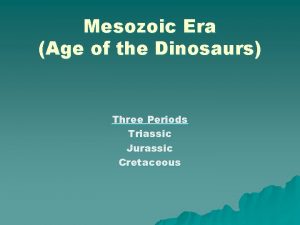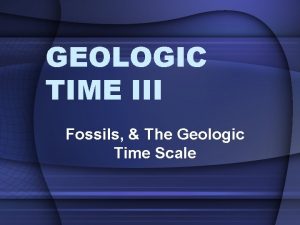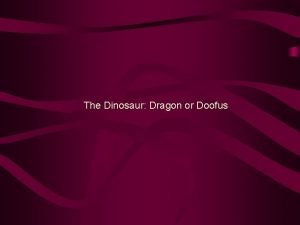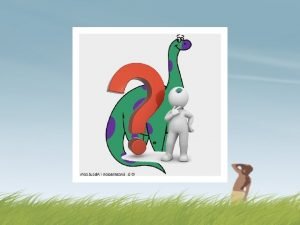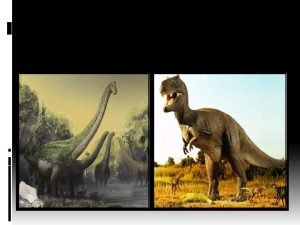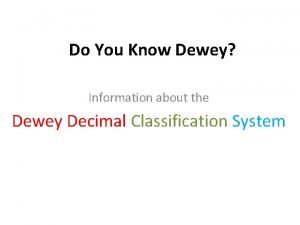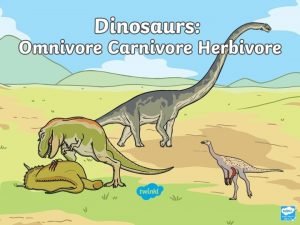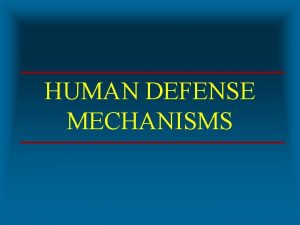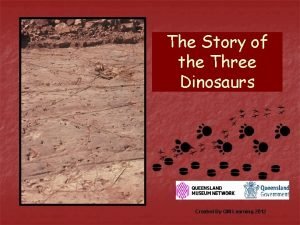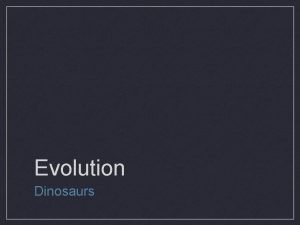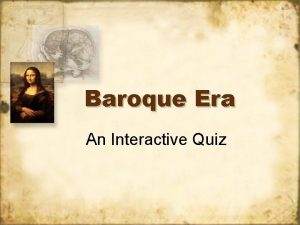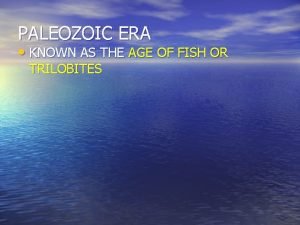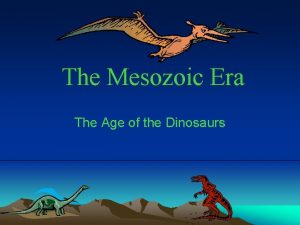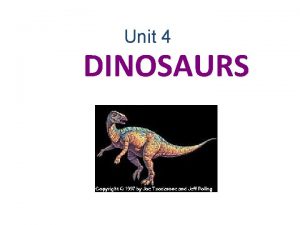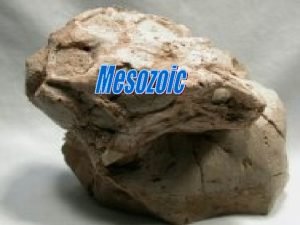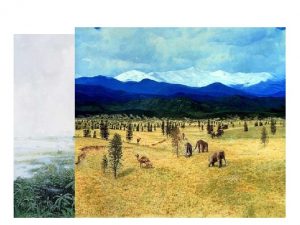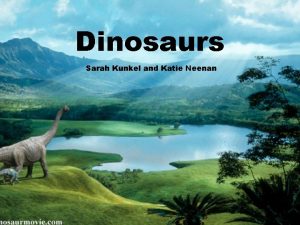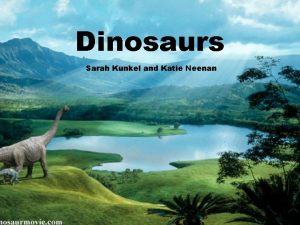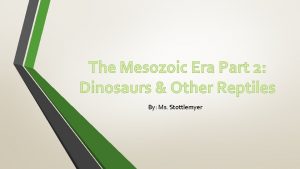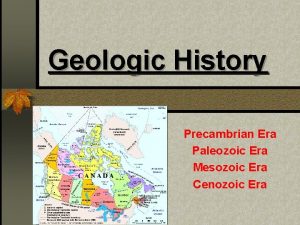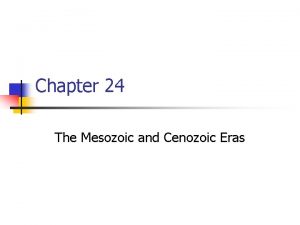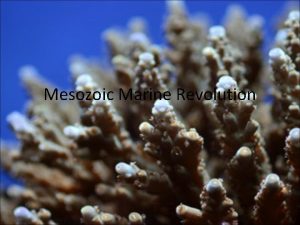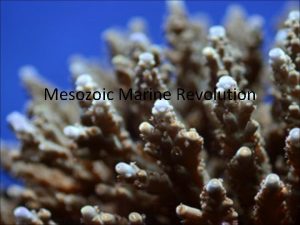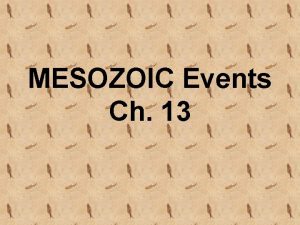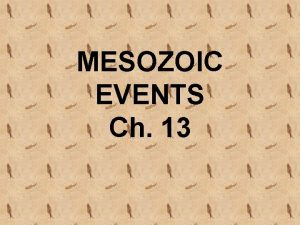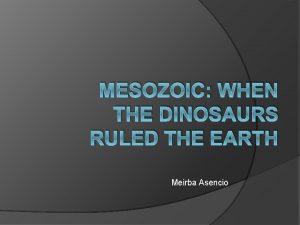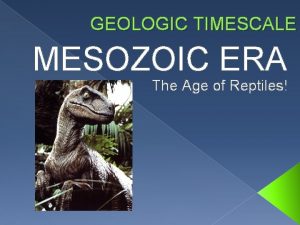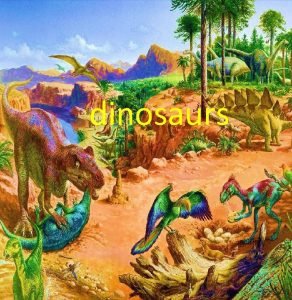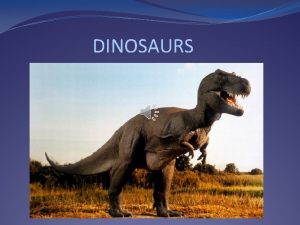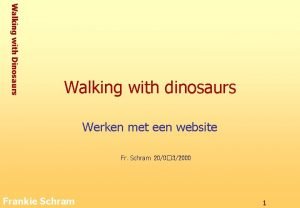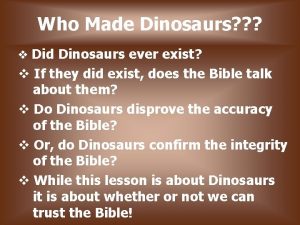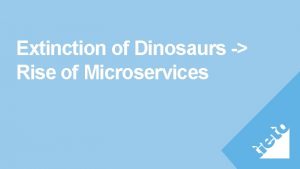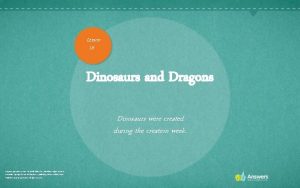Mesozoic Era Age of the Dinosaurs Three Periods

























- Slides: 25

Mesozoic Era (Age of the Dinosaurs) Three Periods Triassic Jurassic Cretaceous

MESOZOIC ERA u KNOWN AS THE MIDDLE ERA u TIMEFRAME: Occurred between 248 to 65 million years ago

IMPORTANT EVENT u Time marked by rapid movements of plates u u A major geologic event of the Mesozoic was the break-up of the super continent of Pangaea into several large continents. u HAD WARM CLIMATE

Mesozoic Era Triassic Period (225 -180 MYA) Pangaea (supercontinent) existed

PANGAEA

¡LAND (GEOLOGICAL) FEATURES THAT FIRST APPEARE:

Mesozoic Era Cretaceous Period (135 -65 MYA) Flower plants CALLED (angiosperms) 1 ST APPEARED

¡ANIMALS/ORGANIS MS (BIOLOGICAL) FEATURES THAT FIRST APPEARED:

Mesozoic Era Triassic Period (225 -180 MYA) First Dinosaurs (small in size) Pisanosaurus Length: 3 feet Height: 1 foot Weight: 15 pounds Eoraptor: Length: 3 feet Height: 1 foot Weight: 20 pounds


Mesozoic Era Jurassic Period (180 -135 MYA) Pangaea starts to separate

Mesozoic Era Jurassic Period (180 -135 MYA) 1 st mammals (small rodents).

Mesozoic Era Jurassic Period (180 -135 MYA) 1 st birds (Archaeopteryx). • Jaws and bone structure like dinosaurs • Bones are hollow, like birds • Had feathers

Mesozoic Era Jurassic Period (180 -135 MYA) Reptiles in the sea - Icthyosaurs – 8 m; Plesiosaurs – 15 m.

¡ ANIMALS/ORGANISMS (BIOLOGICAL) & GEOLOGICAL FEATURES THAT BECAME DOMINANT

Mesozoic Era Jurassic Period (180 -135 MYA) Dinosaurs BECAME DOMINANT

Mesozoic Era Cretaceous Period (135 -65 MYA)

Mesozoic Era Cretaceous Period (135 -65 MYA) Continents in modern positions

Mesozoic Era Triassic Period (225 -180 MYA) GYMNOSPERMS BECAME DOMINANT

¡WHAT CATASTROPHIC EVENT CAUSED THE MASS EXTINCTION?

MASS EXTINCTION ¡ Asteroids, METEORITE, or Comets collided into the Earth AND CAUSED Mass Extinction

How could a meteorite impact cause a mass extinction? The impact caused shock waves, tidal waves, and sent a tremendous amount of dust into the atmosphere p As the dust re-entered the Earth’s atmosphere, it would have instantly heated the atmosphere causing tremendous forest fires p Dust from impact blocked out the sun and caused major climate change and plants to die p Plants, animals, etc. went extinct due to the climate changes and competition between organisms ¡

Mesozoic Era Cretaceous Period (135 -65 MYA) Mass Extinction: 50% of all plant and animal groups die out Alvarez’s Meteor Impact Theory- 10 km wide meteorite hits Earth

Scientists now have fresh evidence that such a cosmic impact ended the age of dinosaurs near what is now the town of Chixculub in Mexico.

Mesozoic Era Cretaceous Period (135 -65 MYA) ¡ Evidence of Impact: Iridium l l l An element that is very rare in Earth rocks and very common in meteorites The layer of rocks above the last dinosaur bones contain ~ 160 x normal levels of iridium Called the K/T Boundary
 Paleozoic era vs mesozoic
Paleozoic era vs mesozoic Mesozoic era
Mesozoic era Creating a dinosaur sculpture type of graphic organizer
Creating a dinosaur sculpture type of graphic organizer Cenozoic mesozoic paleozoic
Cenozoic mesozoic paleozoic Stone age chronology
Stone age chronology Iron age bronze age stone age timeline
Iron age bronze age stone age timeline Electromechanical period
Electromechanical period Are flying dinosaurs dragons
Are flying dinosaurs dragons Dinosaurs were reptiles that lived during
Dinosaurs were reptiles that lived during Dinosaur periods
Dinosaur periods Type of dinosaurs
Type of dinosaurs Do you know dewey
Do you know dewey Dinosaurs lived millions of years ago what did they eat
Dinosaurs lived millions of years ago what did they eat The real reason dinosaurs became extinct
The real reason dinosaurs became extinct Categories of defense mechanisms
Categories of defense mechanisms Victorian curriculum science
Victorian curriculum science A whale bone that originally contained 200 grams
A whale bone that originally contained 200 grams Dinosaurs
Dinosaurs Dinosauria cladogram
Dinosauria cladogram Periods in roman history
Periods in roman history Era quiz: the baroque era
Era quiz: the baroque era Victorian era vs elizabethan era
Victorian era vs elizabethan era Creí que era una aventura y en realidad era la vida
Creí que era una aventura y en realidad era la vida Vi uma estrela tão alta
Vi uma estrela tão alta Fish 395 m.y.a
Fish 395 m.y.a Adrenarche
Adrenarche

